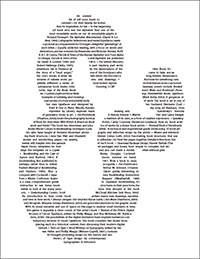 I took over editing the PCBA Ampersand in the fall of 2004. The first issue was a book arts resource guide, and was put together by me and my friend Cathy. We had a lot of fun with the layout—in particular, with the back cover, where we did a shaped ampersand filled with “An esoteric list of still more books to consider—for their beauty, for instruction, for inspiration, for fun.” That’s what it looks like to the left. And below is our list…
I took over editing the PCBA Ampersand in the fall of 2004. The first issue was a book arts resource guide, and was put together by me and my friend Cathy. We had a lot of fun with the layout—in particular, with the back cover, where we did a shaped ampersand filled with “An esoteric list of still more books to consider—for their beauty, for instruction, for inspiration, for fun.” That’s what it looks like to the left. And below is our list…
- In the beginning (of book arts) was the alphabet. And one of the most rereadable works on our 26 remarkable glyphs is Richard Firmage’s The Alphabet Abecedarium (David R. Godine, 1994). Calligraphic letterforms and varied typefaces create a pictorial accompaniment for Firmage’s delightful “genealogy” of each letter.
- Equally addictive reading, with a focus on words and derivations, are two volumes by Alexander and Nicholas Humez. Both A. B. C. Et Cetera, The Life & Times of the Roman Alphabet and From Alpha to Omega, The Life & Times of the Greek Alphabet are published by David R. Godine (1985 and 1981).
- The Sixteen Pleasures, Robert Hellenga (Delta, 1995), is part mystery, part erotic adventure. Set in Florence after the devastations of the 1966 flood, it’s the story of a “mud angel,” one of the foreigners who came to help rescue the city’s books, & what befalls when she discovers a long-hidden Renaissance volume of sixteen erotic poems and drawings.
- And now for something completely different: a series of hard-boiled mysteries that feature an ex-cop turned antiquarian book dealer. John Dunning ’s Cliff Janeway novels include Booked to Die, Sign of the Book, Bookman’s Wake and The Bookman’s Promise.
- Gudrun Zapf von Hesse: Bindings. Handwritten Books. Typefaces. Examples of Lettering and Drawings (Mark Batty, 2002). A gorgeous visual survey of a truly remarkable body of work. The book is set in one of her own typefaces and designed by her husband, Hermann Zapf.
- Point & Line to Plane, Wassily Kandinsky (orig ed Bauhaus, 1926; reprinted by Dover), explores mark-making and Kandinsky’s theories of geometric forms in art.
- The Photobook, A History, Volume 1, Martin Parr and Gerry Badger (Phaidon, 2004), treats the photography book as a medium all its own, as a form of creative expression.
- Speaking of Book Art: Interviews With British & American Book Artists, Cathy Courtney (Anderson-Lovelace). How do book artist work and think? This book has interviews and photos of works by a dozen book artists.
- Penland Book of Handmade Books: Master Classes in Bookmaking Techniques (Lark, 2004). A technical and inspirational guide showcasing 10 book artists who have taught at Penland. Abundant photographs and reflective essays by the artists.
- Woven and Interlocking Book Structures, Claire Van Vliet and Elizabeth Steiner (Janus Gefn, 2002). Fascinating book structures that use woven and interlocking paper—no sewing or adhesive—to bind the pages together. Detailed directions but better still, insights into the genesis of each book.
- Structural Package Design (The Pepin Press). Templates for folded packages and boxes, from simple to complex. Just enlarge the template on a copier and you can build a model, often without glue.
- Bookbinding and the Care of Books, Douglas Cockerell (Lyons and Burford, 1991). A classic volume on hand bookbinding, first published in 1901. Now a book to read, perhaps, rather than to follow as a guide.
- The Thames and Hudson Manual of Bookbinding, Arthur W. Johnson (Thames and Hudson, 1985). Also a classic guide, interesting to compare with Cockerell.
- Japanese Bookbinding: Instructions from a Master Craftsman, Kojiro Ikegami (Weatherhill, 1986) is a clear, comprehensive guide to Japanese bookbinding. It’s instructive to see these book structures in their pure form, the better to look at the many variations that abound in the book arts.
- Understanding Comics, Scott McCloud (Kitchen Sink Press, 1993). An introduction to how comic book writers marry text, drawings, narrative and time in their work.
- Jimmy Corrigan: The Smartest Kid on Earth, Chris Ware (Pantheon, 2000) and Persepolis, Marjane Satrapi (Pantheon, 2003), are good introductions to the graphic novel. With its visual narrative and use of space on the page to explore small moments in time, this genre is arguably a close cousin of the artist’s book.
- Revival of the Fittest: Digital Versions of Classic Typefaces, edited by Philip Meggs and Roy McKelvey (RC Publications, 2000). The possibilities of the digital revolution have inspired numerous contemporary versions of classic typefaces. This book considers two dozen faces, placing each in a historical context, then discussing their modern digital revivals.
- Texts on Type: Critical Writings on Typography, edited by Steven Heller and Phillip Meggs (Watson-Guptill, 2001), contains 50 thought-provoking essays on the history and aesthetics of type design by contemporary
typographers & historians.
